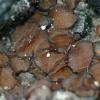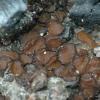
14-05-2015 14:34
 Bernard CLESSE
Bernard CLESSE
Là je pense être sûr de mon coup pour Anthracob

12-05-2015 10:13
Garcia SusanaHi all:Can someone send me the following article ?

15-05-2015 11:29
 Nicolas VAN VOOREN
Nicolas VAN VOOREN
Bonjour.Je cherche l'article suivant:Korf R.P. 196

14-05-2015 23:18
Quijada LuisHi all, I am working with Zotto in an important m

14-05-2015 22:05
 Bernard CLESSE
Bernard CLESSE
À mon avis l'espèce banale mais j'ai appris à m

13-05-2015 09:32
Grandir dans le sol sur une brindille morte avec d
Anthracobia2 sur place à feu
Bernard CLESSE,
14-05-2015 14:34
 Là je pense être sûr de mon coup pour Anthracobia melaloma avec une telle forme de spores et de tels poils.
Là je pense être sûr de mon coup pour Anthracobia melaloma avec une telle forme de spores et de tels poils.a) spores elliptiques-subfusoïdes, biguttulées : 20-23x10-11
b) paraphyses filiformes à extrémité droite et un peu enflée
c) poils hyphoïdes, bruns, longs jusqu'à 125 mu
D'accord pour Anthracobia melaloma ?
Bernard
Gilbert MOYNE,
15-05-2015 10:24
Re : Anthracobia2 sur place à feu
Et si on disait Anthracobia melaloma avec ces grands poils et des spores à peine fusiformes ? Ca ne me choquerait pas....
Gilbert
Gilbert
Bernard CLESSE,
15-05-2015 22:46

Re : Anthracobia2 sur place à feu
Merci pour ta réponse Gilbert !
Bernard
Bernard
René Dougoud,
16-05-2015 09:07
Re : Anthracobia2 sur place à feu
Cher Collègue,
OK pour A. melaloma, la couleur des apothécies est la forme des poils sont caractéristiques.
OK aussi pour A. tristis, posté précédemment, la forme cylindacée des ascospores est typique et la sépare des espèces de même couleur. Mais ascospores toujours à contrôler et à mesurer matures !
René
OK pour A. melaloma, la couleur des apothécies est la forme des poils sont caractéristiques.
OK aussi pour A. tristis, posté précédemment, la forme cylindacée des ascospores est typique et la sépare des espèces de même couleur. Mais ascospores toujours à contrôler et à mesurer matures !
René
Bernard CLESSE,
16-05-2015 20:14

Re : Anthracobia2 sur place à feu
Bonsoir René,
Un tout grand merci pour vos confirmations et remarques notamment sur la forme cylindracée des spores d'A. tristis qui la sépare des espèces de même couleur car je n'avais pas du tout tilté sur ce critère !
Cordialement,
Bernard
Un tout grand merci pour vos confirmations et remarques notamment sur la forme cylindracée des spores d'A. tristis qui la sépare des espèces de même couleur car je n'avais pas du tout tilté sur ce critère !
Cordialement,
Bernard



